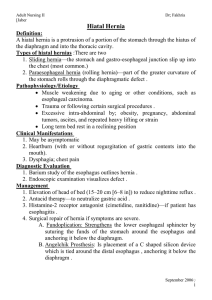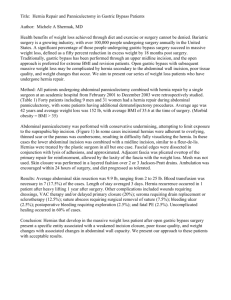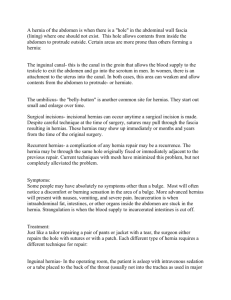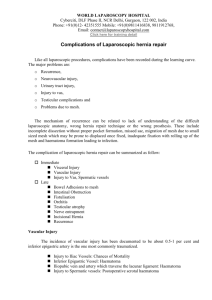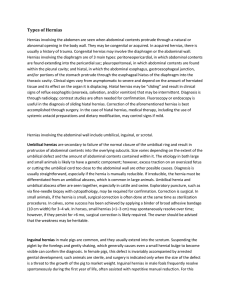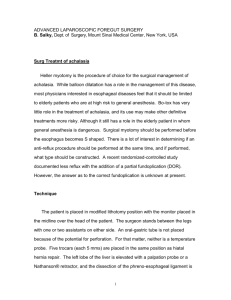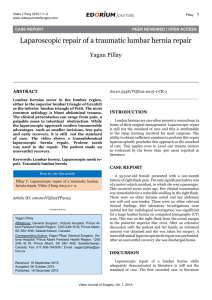Laparoscopic Paraesophageal Hernia
advertisement
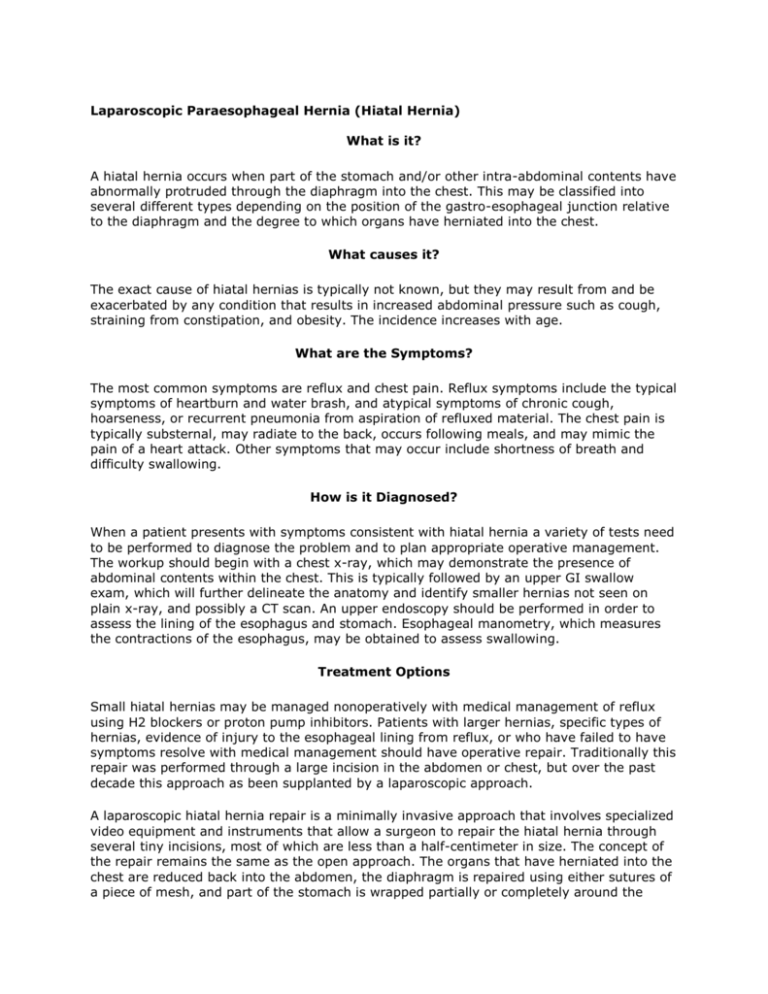
Laparoscopic Paraesophageal Hernia (Hiatal Hernia) What is it? A hiatal hernia occurs when part of the stomach and/or other intra-abdominal contents have abnormally protruded through the diaphragm into the chest. This may be classified into several different types depending on the position of the gastro-esophageal junction relative to the diaphragm and the degree to which organs have herniated into the chest. What causes it? The exact cause of hiatal hernias is typically not known, but they may result from and be exacerbated by any condition that results in increased abdominal pressure such as cough, straining from constipation, and obesity. The incidence increases with age. What are the Symptoms? The most common symptoms are reflux and chest pain. Reflux symptoms include the typical symptoms of heartburn and water brash, and atypical symptoms of chronic cough, hoarseness, or recurrent pneumonia from aspiration of refluxed material. The chest pain is typically substernal, may radiate to the back, occurs following meals, and may mimic the pain of a heart attack. Other symptoms that may occur include shortness of breath and difficulty swallowing. How is it Diagnosed? When a patient presents with symptoms consistent with hiatal hernia a variety of tests need to be performed to diagnose the problem and to plan appropriate operative management. The workup should begin with a chest x-ray, which may demonstrate the presence of abdominal contents within the chest. This is typically followed by an upper GI swallow exam, which will further delineate the anatomy and identify smaller hernias not seen on plain x-ray, and possibly a CT scan. An upper endoscopy should be performed in order to assess the lining of the esophagus and stomach. Esophageal manometry, which measures the contractions of the esophagus, may be obtained to assess swallowing. Treatment Options Small hiatal hernias may be managed nonoperatively with medical management of reflux using H2 blockers or proton pump inhibitors. Patients with larger hernias, specific types of hernias, evidence of injury to the esophageal lining from reflux, or who have failed to have symptoms resolve with medical management should have operative repair. Traditionally this repair was performed through a large incision in the abdomen or chest, but over the past decade this approach as been supplanted by a laparoscopic approach. A laparoscopic hiatal hernia repair is a minimally invasive approach that involves specialized video equipment and instruments that allow a surgeon to repair the hiatal hernia through several tiny incisions, most of which are less than a half-centimeter in size. The concept of the repair remains the same as the open approach. The organs that have herniated into the chest are reduced back into the abdomen, the diaphragm is repaired using either sutures of a piece of mesh, and part of the stomach is wrapped partially or completely around the esophagus in order to prevent further reflux symptoms. The advantages of this method include a shorter hospitalization, less pain, fewer and smaller scars, and a shorter recovery. Laparoscopic hernia repair is a safe and effective treatment for hiatal hernias. However, in the presence of infection, adhesions, or variations in anatomy, this method becomes dangerous and your surgeon may need to make the prudent decision to continue by making the traditional incision to safely complete the operation. This should not be seen as a failure, but as a wise decision by your surgeon to prevent dangerous complications. Other complications, although rare, include bleeding and infection. It is uncommon to require a blood transfusion for this operation. There is a slight risk of injury to the esophagus, liver, stomach, bowel, lung, and spleen. Post-operatively, rare problems may occur. These include difficulty with swallowing or the repaired area slipping back into the chest. Preparations before Surgery In an otherwise healthy person, little is required to prepare for surgery. Depending on your age, gender, and health problems, some routine blood tests, an EKG and a chest x-ray may or may not be needed. Your surgeon or family doctor will order these tests as needed. You will be asked to refrain from eating 8 hours before surgery. Be sure to let your doctor know what medications you are taking, as some will need to be stopped before surgery. In general, all blood thinners need to be stopped for several days. These include aspirin, Ibuprofen or Motrin, Coumadin and Plavix. How is Laparoscopic Hernia Repair Accomplished? This operation is generally performed with general anesthesia. An IV line will be placed in your arm for fluids and you will be brought into the operation room. The anesthesiologist and nurses will use monitors to check your heart rate and breathing during the procedure. These may include EKG leads, a blood pressure cuff, an oxygen mask and sleeves on your legs to prevent clots from forming. Once you are asleep, the operating room team will work together to perform your operation. When your operation is complete, you will be awakened from anesthesia in the operating room but you may not remember this. After a few hours in the recovery room you will be transferred to the surgical ward. It is common to feel groggy and nauseated soon after surgery and medication is available to help with these discomforts. You will gradually be allowed to increase your intake by mouth, first liquids only followed by soft then regular solid food. Once your surgeon feels your recovery has been appropriate, meaning you are able to eat and drink adequate quantities and you pain is adequately controlled with pills, you will be discharged to home. Care of Incisions Your incisions will be swollen, pink, and may be numb and bruised with a small amount of clear pink drainage. This is normal. After 2 days, you may shower and gently wash them with a mild soap and water. Do not use soaps with lotion or heavy fragrance. They can disrupt new skin growth. Do not put lotions, powders, or ointments on the wounds. Do not swim or soak in a bathtub or hot tub until they are healed. This may be 2 weeks or longer. Check incision daily for signs of infection. Increased redness and warmth at the incision site Pus-like drainage Excess swelling or bleeding Temperature by mouth greater than 100.4° F, for two readings taken 4 hours apart If there is drainage from your wounds, wear a Band-Aid® until it stops. Change the dressing at least daily and more often as needed. Pain Relief Expect to have some pain from the surgery. Pain pills will be prescribed by your doctor. If you had a laparoscopic repair, you may have shoulder pain from gas in your belly that presses on your diaphragm. This pain can be relieved by getting up and walking. Your nurses will discuss this with you. Prevent Constipation Be sure to drink at least 6-8 glasses of fluid each day. If you are taking pain pills every 4-6 hours, you may need to take over-the-counter stool softeners (docusate sodium) and/or a fiber laxative (Benefiber®) to keep stool moving easily. Talk to your nurse or doctor if you are having problems with bowel movements. Diet You will be on a pureed diet for 2 weeks. Once on solid food, chew your food well. Prevent swallowing excess air. Do not use straws. Do not chew gum or tobacco. Avoid foods that cause gas. Activities Walk 3 times a day. Nothing strenuous until okayed by your doctor. For the first 4-6 weeks, do not lift more than 20 pounds. After 4 weeks, you will be able to slowly increase your level of activity. Do not drive for 1 week or while you are taking narcotic pain pills. Check with your doctor before going back to work. Wear loose clothing around your waist. When to Call the Doctor Problems swallowing Pain with swallowing Feeling that food is getting stuck Nausea or vomiting Bloating Pain not controlled with pain pills Increased redness or warmth around the incision Pus-like drainage from the incision Excess swelling or bleeding from the site. Temperature greater than 100.4°F by mouth, for two readings taken 4 hours apart.

